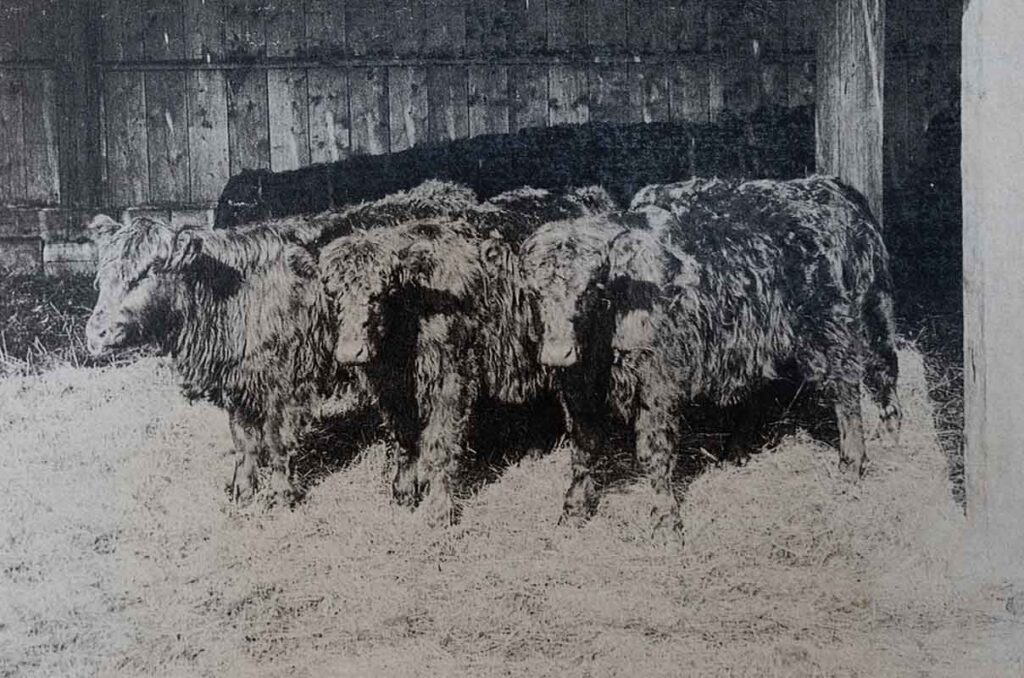
In the late summer of 1902 my father went to Cheyenne, Wyoming, and purchased some 500 head of Hereford cows and heifers and also some bulls. These cattle were all purebred Herefords but registration papers had not been kept up. They wore the Mallet brand on the left ribs and hip, and as I remember, a Mr. Gibson made the sale to my father. They were shipped into a railroad siding near Cutbank, Montana, called Baltic. After unloading them at Baltic, we drove them a distance of some 65 miles to the ranch. A big, mammoth Jack, for raising mules, and a Clydesdale stallion were also included in the shipment. A pasture comprising half a township was set aside for these Hereford cows and from that time onward we raised Hereford bulls both for our own use and for sale to other ranchers. The pasture used for these cows was called the White-face pasture and part of it still continues under that name.
My father went to Sparks, Nevada, and purchased a carload of Hereford bulls from the then Governor Sparks of Nevada for use un this herd of Hereford cows. These bulls were all sired by HESOID II. Shorthorn bulls were gotten rid of and our ranch from that time on used only Hereford and Black Galloway bulls which were turned loose together in the range herd. The Galloway-Hereford cross produced a lot of very good, polled, black, bald-faced cattle.

In 1905 my father purchased a carload of Hereford bulls from Overton Harris of Harris, Missouri, for use in his Hereford breeding herd, and this bunch grew into very large, smooth bulls and left a real mark in our cattle. They were largely from a bull named SHAMROCK and were bred by John G. Thomas, Harris, Missouri, and had been purchased from Mr. Thomas by Mr. Harris for re-sale. However, a few of them were sired by old BEAU DONALD 5th, one of the Harris sires at that time. From that time onward we have imported numerous Hereford bulls from the United States for the purpose of raising our own herd sires and for supplying other ranchers and farmers with bulls. In those days bull sales were made in bunches ranging up to 50 head. Nowadays, the usual demand is from one to five bulls.

The Galloway herd was disposed of in 1916 because we did not have sufficient pastures to maintain two purebred herds. In 1917 registered Hereford heifers were purchased from A. B. Cook of Townsend, Montana, Frank Collicutt of Crossfield, Alberta, and later from the W. H. Curtice herd at Sheppard, Alberta. This registered herd has been maintained and kept at a size of 250 head of females.
A big country lying between the United States Boundary and the north branch of the Milk River and comprising some 80,000 acres had been leased by the Knight Sugar Company from the Dominion Government along about 1902. They subsequently re-leased it to my father, and this range, now known as the Del Bonita and Twin River country, became our summer range. All of our cattle, with the exception of the Galloway herd and the Hereford herd, were turned onto this country in May of each year and brought back to our home ranch during the latter part of November of each year for wintering. This lease continued until 1912 when it was thrown open for homesteads entry and settlers came in taking up homesteads and pre-emptions and broke up a good part of the land for wheat farming. Some settlers started out with only a wagon and a shovel. They spaded up a little potato patch with the shovel and erected a small sod shack. A few of these shovel settlers stuck it out for sometime while others quit. Their holdings passed on to other settlers and now the whole district is fairly prosperous.
